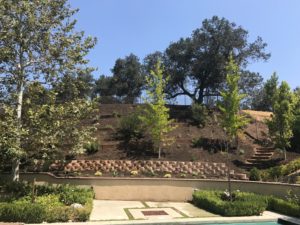The northern part of the Los Angeles metropolitan area is dominated by hills and valleys with many properties within this area situated on sloped terrains. Beacause of this, Creative Concepts Landscape receives many requests for the construction of landscape terraces.

The Crescenta Valley – The mountains, hills, and valleys create many sloped landscapes
Terracing is the construction of retaining lines on a slope to help hold the soil in place. These lines can be made from different materials such as concrete, wood, or stone (more on the material choices below).
Terraces are used for two main reasons:
- Erosion control – terracing will help hold soil in place on a slope
- Creating leveled, useable space on a slope – by constructing terraces and then importing soil behind the terrace (back filling) we can create a leveled area between terrace walls for more useable space on slopes
Types of terraces:
- Stone (natural and formed) – Stone terraces can be made with rocks in their natural shape or ones that have been formed. Formed stones have a more manicured appearance and fit together with clean lines, whereas naturally shaped stones have a more rustic aesthetic. Both are excellent options depending on the overall design of the house and landscape. To create terraces, these materials can either be connected with mortar or concrete or can be placed to rest upon each other without an adhesive.

A more uniform natural-aesthetic stone wall
![]()

A large natural-aesthetic stone wall with various sized boulders
- Wood – When it comes to wood terraces, we prefer to use redwood here at Creative Concepts Landscape. This wood looks great and lasts longer than many other types. Wood terraces can either be made with larger pieces for taller terrace walls, or with smaller lines for erosion mitigation when the problem is less severe.

Wood terrace lines hold soil across this large slope

Tall redwood terrace walls being built
- Concrete – Concrete garden block retaining walls have become fairly popular options. They look nice and are relatively inexpensive. They also can be used to create curved walls, adding a pleasant aesthetic that increases the wall’s strength. For larger walls that need to provide more structural security, masonry terraces are a smart choice.

Concrete garden block retaining walls

Concrete masonry terrace walls
Terraces are constructed in a line (often multiple lines) going perpendicular to the downward grade of the slope. Depending on the material used, the lines are held in place with anchor points such as rebar, stakes, metal poles, or concrete footings.

A walkway terrace with redwood seats and handrails
The soil area directly behind the retaining line is often graded to level, or near level. This is not always the case, but when it is done it can help turn what was a steep slope into more usable yard space. You can put various plants or even an edible garden or a fruit tree orchard.

Backfilled planters behind redwood terrace walls create additional garden space
Leveling terrace plans is not always necessary, and they are often left at a slight decline, on which plants will add even more erosion control and beauty. There are many possibilities in how terraced areas can be used.
Creative Concepts Landscape will happily do the labor and time intensive work of creating beautiful and sturdy terraces for your property landscape. Contact us today to find out more.
By Daniel Williams
Client Laison for Creative Concepts Landscape


Excellent blog post, I loved the pictures!
Thank you!
Interesting, unique article. please keep it up!
Thank you! Will do.